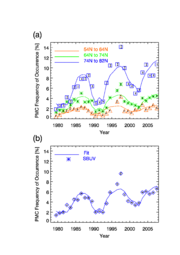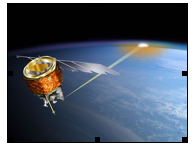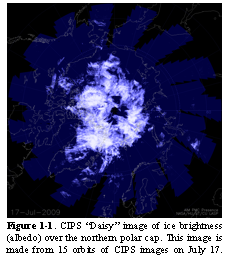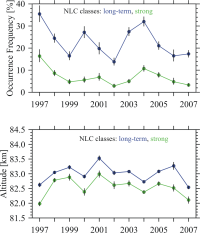Project 3 PMC/NLC altitude, frequency and brightness changes related to changes in dynamics and chemical composition
From CAWSES
- Project leaders: G.Thomas (USA), U.Berger (Germany)
- Project members: S. Bailey (USA),G. Baumgarten(Germany),M. DeLand (USA), J. Fiedler (Germany),B. Karlsson (Sweden), S. Kirkwood (Sweden), A. Klekociuk (Australia), F.-J. Lübken (Gemany), A. Merkel (USA), N. Pertsev (Russia), J. Russell III (USA), E. Shettle (USA)
Contents |
Introduction
The 20-yr old speculation that high-altitude summertime ice clouds (polar mesospheric clouds or noctilucent clouds, here denoted MC) are affected by anthropogenic activities has recently received support from a 30-year time series of SBUV (Solar Backscatter Ultraviolet) satellite measurements (see Figure 1). SBUV data reveal a significant trend in bright MC properties. However, the robustness of the trend, extracted from interannual, local-time and solar-cycle variability, and its underlying causes remains debatable. It is important to understand the relative roles of these three factors (solar, inter-annual and long-term forcing) before a definitive long-term trend can be evaluated. Furthermore the problem of attribution, that is, the nature of the various forcings on ice formation is not yet understood. For example with respect to the long-term changes, is a lowered temperature due to higher carbon dioxide responsible for the observed increase in brightness and occurrence frequency of MC? Or are water vapor changes due to oxidation of methane responsible, since we know that lower atmospheric methane has more than doubled over the past 120 years, and methane oxidation leads to upper atmospheric water vapor. The failure to detect any changes in the altitude of MC since the first measurement made by Otto Jesse in the late nineteenth century has provided an important constraint, since water vapor changes and temperature changes affect cloud altitude in different ways. Fortunately, the state of the art in modeling has now reached a point where ice formation is coupled with general circulation models. Recent results are reported in the references below:

References
- Luebken, F.-J., U. Berger, and G. Baumgarten (2009), Stratospheric and solar cycle effects on long-term variability of mesospheric ice clouds, J. Geophys. Res., 114, D00I06, doi:10.1029/2009JD012377
- Merkel, A. W., Marsh, D. R., Gettelman, A., and Jensen, E. J.: On the relationship of polar mesospheric cloud ice water content, particle radius and mesospheric temperature and its use in multi-dimensional models, Atmos. Chem. Phys., 9, 8889-8901, 2009
- Merkel, A. W., D. Marsh, G. E. Thomas, C. Bardeen, M. Deland, WACCM simulations of long-term changes in polar mesospheric clouds, Layered Phenomenon in Mesospheric Regions (LPMR) Conference, Stockholm, 2009
- Marsh, D and A. W. Merkel, 30-year PMC variability modeled by WACCM, SA33B-08, Fall AGU Meeting, San Francisco, 2009
- Shettle,E. P.,M. T. DeLand, G. E. Thomas, and J. J. Olivero (2009), Long term variations in the frequency of polar mesospheric clouds in the Northern Hemisphere from SBUV, Geophys. Res. Lett., 36, L02803, doi:10.1029/2008GL036048.
Workshops and Meetings
The first workshop under the auspices of this working group was held in Boulder, Colorado on December 10 & 11, 2010, entitled Modeling Trends in mesospheric clouds. A short meeting report will be published: Reference: December 2009 PMC Trend Meeting Report entitled Mesospheric ice clouds as indicators of upper atmosphere climate change, accepted by EOS, publication date April 2010
In addition, The 6th IAGA/ICMA/CAWSES workshop on “Long-Term Changes and Trends in the Atmosphere [2] will be held at National Center for Atmospheric Research (NCAR) Center Green Conference Center, Boulder, Colorado, USA, June15-18, 2010, the week before the 2010 CEDAR (Coupling, Energetics, and Dynamics of Atmospheric Regions) workshop [3], which will also be held in Boulder.
Observing Facilities
Aeronomy of Ice in the Mesosphere (AIM), a NASA satellite mission (2007-)
AIM was launched from Vandenberg Air Force Base on April 25, 2007 becoming the first satellite mission dedicated to the study of Polar Mesospheric Clouds (PMCs). A Pegasus XL rocket placed the AIM satellite into a near circular (601 km apogee, 595 km perigee), 12:00 AM/PM sun-synchronous orbit. By measuring PMCs and the thermal, chemical and dynamical environment in which they form, AIM will quantify the connection between these clouds and the meteorology of the polar mesosphere. In the end, this will provide the basis for study of long-term variability in mesospheric climate and its relationship to global change. The results of AIM will be a rigorous test and validation of predictive models that then can reliably use past PMC changes and current data to assess trends as indicators of global change. This goal is being achieved by measuring PMC densities, spatial distribution, particle size distributions, gravity wave activity, meteoric smoke influx to the atmosphere and vertical profiles of temperature, H2O, O3, CH4, NO, and CO2.The overall goal of AIM is to resolve why PMCs form and why they vary. It has been suggested that the observed changes in the clouds are related to increased concentrations of greenhouse gases. This suggestion is plausible because an increase in carbon dioxide, while warming the surface of the Earth, cools the upper atmosphere which can facilitate mesospheric cloud formation there. Additionally, increases in methane at the surface of the Earth lead to increases in water vapor at high altitudes through chemical oxidation processes, which further facilitates cloud formation and growth. While plausible, this greenhouse gas hypothesis has not yet been proven.The AIM webpage is at [4] --Gary.thomas 20:42, 1 April 2010 (UTC)
Arctic Lidar Observatory for Middle Atmosphere Research (ALOMAR)
The Rayleigh/Mie/Raman (RMR) lidar at the Arctic Lidar Observatory for Middle Atmosphere Research (ALOMAR) is located on top of a ≈400 m high mountain in Northern Norway (69.3°N, 16.0°E). It was installed in 1994 and designed for multi-parameter investigations of the Arctic middle atmosphere on a climatological basis. Because of its Arctic location, the lidar is optimized for measurements during full sunlight. Appropriate technical solutions, laser wavelength stabilization in combination with strong spectral as well as spatial filtering at the receiving system, have been implemented. The lidar is a complex twin-system consisting of two power lasers, two receiving telescopes, and one optical bench for spectral separation and filtering of the light received from the atmosphere. The lasers emit pulses at three wavelengths (355 nm, 532 nm, 1064 nm) simultaneously with an overall peak power of 150 MW per laser. The backscattered light from the atmosphere is collected by telescopes with a diameter of 1.8 m each. They can be tilted up to 30° off-zenith to allow different viewing directions (Fig. 1), which separates the sounding volume up to 90 km at an altitude of 80 km. After spectral and intensity separation the light is analyzed by 15 channels and recorded by single photon counting detectors. One main objective of the RMR-lidar is the observation of ice layers in the mesopause region, which are known as noctilucent clouds (NLC) and polar mesospheric clouds (PMC). Throughout the NLC season (1 June to 15 August) the lidar is operational for 24 hours per day to measure whenever permitted by the local weather conditions. This yielded a total of more than 4000 measurement hours from 1997 to 2009. NLC were observed during ≈1700 hours which is the largest NLC data base acquired by lidar. The data are used to investigate decadal scale changes of NLC parameters, size and number density of the ice particles, as well as small scale structures which are often observed in the cloud layers. Fig. 2 shows the time series of NLC occurrence and altitude above ALOMAR covering one solar cycle (taken from reference 2). During these 11 years there is no statistical significant anti-correlation between cloud occurrence and solar activity, which is partly in contrast to other data sets. The mean cloud altitude is 83.2 km and appears to remain nearly unchanged since the first NLC observations more than 100 years ago.
""Visual Observations of Noctilucent Clouds""
Scientific interest in noctilucent clouds (NLC) can be traced back to 1884 when many observers watched the twilight sky to see the dramatic sunsets caused by dust from Krakatoa, which had erupted during the previous year. Captivating displays of 'night shining' clouds, were seen and quickly recognized as lying at much higher altitude than normal clouds. For much of the 20th century, visual and photographic observations were the only methods available for systematic monitoring of NLC characteristics. By the early 1960's it was clear that their occurrence rates varied enormously from year to year. Widespread, intense displays of NLC were seen for a few consecutive summers, with NLC reported from somewhere around the 50 - 60 N latitude band almost every night over the summer season. These periods were followed by years when almost no NLC at all were seen. The most notable 'high spots' for NLC were the years 1885-1890 and 1963-1968, which were each followed by strong declines in NLC reports even though the same observers as during the 'hot spots' continued to look for them (reference 1).Starting with the International Geophysical Year in 1958, professionally organized observing networks started to gather systematic records of visual sightings of noctilucent clouds (see references). Even though professional involvement has generally ended, or become sporadic, systematic NLC observations are still collected by networks of enthusiasts, in Europe, Russia, Canada and North America. Since 1996, visual observations by members of the public are collected at a number of regional or national centers [5], and since 1996 at the 'Noctilucent Cloud Observers Homepage' [ http://www.kersland.plus.com/]. NLC observations from the UK and Denmark since 1964 form the longest continuous record (observing latitudes from 51 - 61 N). These show how NLC are most common in years of low solar activity, and rare in years of high solar activity. They do not show any significant increase over the last 45 years although a few percent increase (or decrease) cannot be ruled out (Fig. 2, reference 3).
Although monitoring of large-scale structures and possible trends in NLC is being taken over by satellite measurements, visual and photographic observations still have an important role to play. For example, they are the best method available for studying fine-scale structure, on scales of 10s of km or less, and they can be instrumental in identifying NLC at unusually low latitudes where satellites observations and ground-based remote sensing instruments are not available.
- Fogle,B.and B.Haurwitz,Long term variations in noctilucent cloud activity and their possible cause, in Climatological Research,edited by K.Fraedrich, M.Hantel,H.Claussen Korff,and E.Ruprecht,pp. 263–276,Heft 7,Bonner Meteorologische Abhandlungen.,Bonn,Germany,1974.
- Romejko, V.A., P.A. Dalin, N.N. Pertsev, Forty years of Noctilucent Clouds observations near Moscow: database and simple statistics, J. Geophys. Res., 108, D8, 8443, doi: 10.1029/2002JD002364, 2003.
- Kirkwood, S., P. Dalin, A. Rechou, Noctilucent clouds observed from the UK and Denmark – trends and variations over 43 years, Annales Geophysicae, 26, 1243-1254, 2008.





![Fig. 2 A comparison of solar activity and the seasonal NLC frequency of occurrence according to reports of visual observations from the UK and Denmark (from Reference 3, extended to 2009 using internet reports [1])](/wiki/images/3/3c/NLC_UK_Denmark_sm.jpg)

